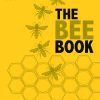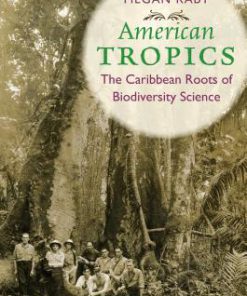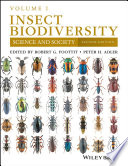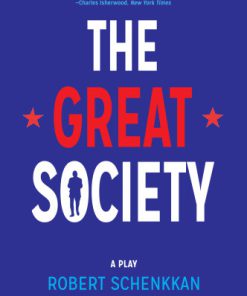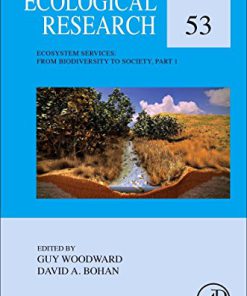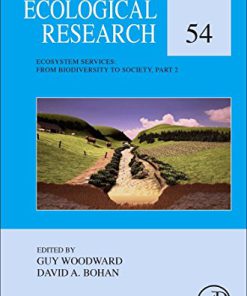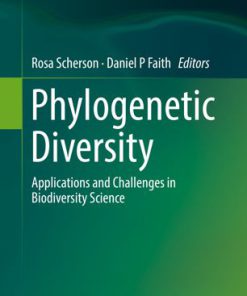Insect Biodiversity Science and Society Science and Society 1st Edition by Robert G Foottit, Peter H Adler ISBN 111894559X 9781118945599
$50.00 Original price was: $50.00.$25.00Current price is: $25.00.
Insect Biodiversity Science and Society Science and Society 1st Edition by Robert G Foottit, Peter H Adler – Ebook PDF Instant Download/Delivery: 111894559X, 9781118945599
Full download Insect Biodiversity Science and Society Science and Society 1st Edition after payment

Product details:
ISBN 10: 111894559X
ISBN 13: 9781118945599
Author: Robert G Foottit, Peter H Adler
Volume Two of the new guide to the study of biodiversity in insects Volume Two of Insect Biodiversity: Science and Society presents an entirely new, companion volume of a comprehensive resource for the most current research on the influence insects have on humankind and on our endangered environment. With contributions from leading researchers and scholars on the topic, the text explores relevant topics including biodiversity in different habitats and regions, taxonomic groups, and perspectives. Volume Two offers coverage of insect biodiversity in regional settings, such as the Arctic and Asia, and in particular habitats including crops, caves, and islands. The authors also include information on historical, cultural, technical, and climatic perspectives of insect biodiversity. This book explores the wide variety of insect species and their evolutionary relationships. Case studies offer assessments on how insect biodiversity can help meet the needs of a rapidly expanding human population, and examine the consequences that an increased loss of insect species will have on the world. This important text: Offers the most up-to-date information on the important topic of insect biodiversity Explores vital topics such as the impact on insect biodiversity through habitat loss and degradation and climate change With its companion Volume I, presents current information on the biodiversity of all insect orders Contains reviews of insect biodiversity in culture and art, in the fossil record, and in agricultural systems Includes scientific approaches and methods for the study of insect biodiversity The book offers scientists, academics, professionals, and students a guide for a better understanding of the biology and ecology of insects, highlighting the need to sustainably manage ecosystems in an ever-changing global environment.
Insect Biodiversity Science and Society Science and Society 1st Table of contents:
Chapter 1: Introduction – A Brief History of Revolutions in the Study of Insect Biodiversity
1.1 Discovery
1.2 Conceptual Development
1.3 Information Management
1.4 Conclusions
Acknowledgments
References
Part I Habitats and Regions
Chapter 2: Insect Biodiversity in the Arctic
2.1 Documenting Biodiversity – Traditional Taxonomy Versus DNA Barcoding
2.2 Insect Species Diversity in the Arctic
2.3 Historical Insect Biodiversity in the Arctic – the Time Perspective
2.4 Biodiversity on the Landscape Scale
2.5 Important Characteristics of Arctic Insect Biodiversity
2.6 Cold Tolerance – a Diversity of Adaptations
2.7 Dispersal, Immigration, and Biodiversity
2.8 Pollinator Networks and Pollinator Biodiversity
2.9 A Biodiversity Paradise for Parasites?
2.10 Biodiversity and the Changing Arctic Climate
References
Chapter 3: Insect Biodiversity in Indochina: A Window into the Riches of the Oriental Region
3.1 Physical Geography and Climate
3.2 Features of Insect Biodiversity in the Lower Mekong Subregion
3.3 Insect Biodiversity and Society in Indochina
3.4 Conclusions
Acknowledgments
References
Chapter 4: Biodiversity of Arthropods on Islands
4.1 What is an Island?
4.2 Ecological Attributes of Islands
4.3 Evolution on Islands
4.4 Evolution in Other Insular Environments
4.5 Characteristics of Island Biodiversity
4.6 Conservation
4.7 Conclusion
References
Chapter 5: Beneficial Insects in Agriculture: Enhancement of Biodiversity and Ecosystem Services
5.1 Components of Biodiversity: Species Richness, Species Evenness, and Species Identity
5.2 Why Does Insect Biodiversity Matter to Agriculture?
5.3 Degradation of Biodiversity Through Agricultural Intensification, and Its Reversal
5.4 Restoring Biodiversity to Agroecosystems
5.5 Conclusions and Recommendations
5.6 Summary
Acknowledgments
References
Chapter 6: Insects in Caves
6.1 The Story of Leptodirus hochenwartii
6.2 The Variety of Subterranean Spaces
6.3 Ecological Roles of Insects in Caves
6.4 Morphological and Life‐History Adaptations of Insects to Subterranean Life
6.5 Probable Modes of Successful Colonization of Subterranean Space
6.6 Taxonomic and Geographic Patterns of Subterranean Insect Biodiversity
6.7 Human Utility and Protection of Cave Insects
References
Part II: Taxa
Chapter 7: Biodiversity of the Thysanurans (Microcoryphia and Zygentoma)
7.1 Paleontological Data
7.2 Parasitism
7.3 Predation
7.4 Order Microcoryphia (= Archaeognatha)
7.5 Order Zygentoma (= Thysanura Sensu Stricto)
7.6 Genetic Studies of Thysanurans
7.7 Thysanurans and Humans
7.8 Geographic Distribution of the Thysanurans
References
Chapter 8: Biodiversity of Zoraptera and Their Little‐Known Biology
8.1 Morphology
8.2 Life History and Ecology
8.3 Reproduction
8.4 Phylogenetic Position – “The Zoraptera Problem”
8.5 Conclusion
Acknowledgments
References
Chapter 9: Biodiversity of Embiodea
9.1 Diversity in Habitat and Silk
9.2 The Promise of Silk‐Like Biomaterials and Emerging Lessons from Webspinners
9.3 Social Behavior
9.4 Families of Embiodea
9.5 Webspinners of the Fossil Record
9.6 Conclusion
References
Chapter 10: Biodiversity of Orthoptera
10.1 Taxonomic Classification and Phylogeny
10.2 Diversity and Distribution
10.3 Morphological and Biological Diversity
10.4 Societal Importance
10.5 Overview of Taxa
Acknowledgments
References
Chapter 11: Biodiversity of Phasmatodea
11.1 Phasmatodean Phylogeny
11.2 Overview of Taxa
11.3 The Phasmatodean Fossil Record
11.4 Phasmatodea as Research Tools
11.5 Importance to Human Society
References
Chapter 12: Biodiversity of Dermaptera
12.1 Epizoic Dermaptera
12.2 Structure and Function
12.3 Locomotion
12.4 Distribution
12.5 Development and Reproduction
12.6 Behavior
12.7 Parasitism and Symbiosis
12.8 Fossils and Research History
12.9 Overview of Taxa
12.10 Societal and Scientific Importance
Acknowledgments
References
Chapter 13: Biodiversity of Grylloblattodea and Mantophasmatodea
Grylloblattodea
13.2 Mantophasmatodea
13.3 Fossil Record
13.4 Conclusions
Acknowledgments
References
Chapter 14: Biodiversity of Blattodea – the Cockroaches and Termites
14.1 Overview of Taxa
14.2 Societal Importance
References
Chapter 15: Biodiversity of Mantodea
15.1 Morphological and Biological Diversity
15.2 Phylogeny and Classification
15.3 Morphological Convergence and Ecomorphs
15.4 Conclusions
References
Chapter 16: Biodiversity of Psocoptera
16.1 Classification
16.2 Overview of the Psocoptera
16.3 Summary of Diversity of the Psocoptera and Predictions
16.4 The Importance to Humans of Psocopteran Biodiversity
Acknowledgments
References
Chapter 17: Biodiversity of Ectoparasites: Lice (Phthiraptera) and Fleas (Siphonaptera)
17.1 Phthiraptera – TheParasitic Lice
17.2 Siphonaptera – The Fleas
17.3 Medical and Veterinary Importance
17.4 Community Diversity of Lice and Fleas
17.5 Conservation of Lice and Fleas
Acknowledgments
References
Chapter 18: Biodiversity of Thysanoptera
18.1 What Are Thrips?
18.2 Family Diversity
18.3 The Lives of Thrips
18.4 Thrips Around the World
18.5 Thrips as Research Targets
18.6 Structural Diversity of Thrips
18.7 Thrips as Pests
18.8 Thrips and Human Life
18.9 Thrips Information Sources
References
Chapter 19: The Diversity of the True Hoppers (Hemiptera: Auchenorrhyncha)
19.1 Overview of the Auchenorrhyncha
19.2 Prospectus
Acknowledgments
References
Addendum
Chapter 20: The Biodiversity of Sternorrhyncha
20.1 Sternorrhyncha and Society
20.2 Taxonomic Diversity of Sternorrhyncha
20.3 Functional Diversity of Sternorrhyncha
20.4 Conclusions
Acknowledgments
References
Chapter 21: Biodiversity of the Neuropterida (Insecta: Neuroptera, Megaloptera, and Raphidioptera)
21.1 Phylogeny
21.2 Geological Age
21.3 Metamorphosis and Life Stages
21.4 Biology
21.5 Distribution
21.6 Overview of Orders and Families
21.7 Societal Importance
21.8 Scientific Importance
Acknowledgments
References
Chapter 22: Biodiversity of Strepsiptera
22.1 Family Bahiaxenidae
22.2 Suborder Mengenillidia
22.3 Suborder Stylopidia
22.4 Infraorder Stylopiformia
22.5 Conclusions
Acknowledgments
References
Chapter 23: Biodiversity of Mecoptera
23.1 Suborder Nannomecoptera
23.2 Suborder Pistillifera
23.3 Societal Value of Mecoptera
23.4 Scientific Value of Mecoptera
23.5 Conclusion
References
Part III: Perspectives
Chapter 24: The Fossil History of Insect Diversity
24.1 Importance of the Insect Fossil Record
24.2 Types of Insect Diversity Past and Present
24.3 Biodiversity Changes Through Time
24.4 Current Societal Aspects of Fossil Insect Biodiversity
24.5 Conclusions
Acknowledgments
References
Chapter 25: Phenotypes in Insect Biodiversity Research
25.1 Phenotype Data: Past and Present
25.2 Phenotype Data: Present and Future
25.3 Challenges and Future Directions
Acknowledgments
References
Chapter 26: Global Change and Insect Biodiversity in Agroecosystems
26.1 Global Change
26.2 Insect Biodiversity in Agriculture
26.3 Effects of Global Change on Biodiversity – What Do We Know?
26.4 Island Versus Continent Contrasts
26.5 Tropical Versus Temperate Issues
26.6 Some Concluding Viewpoints
References
Chapter 27: Digital Photography and the Democratization of Biodiversity Information
27.1 The Digital Insect Collection
27.2 Digital Images in Interactive Keys
27.3 Digital Photography and Taxonomic Revisions
27.4 Organization of Digital Insect Collections
27.5 Conclusions
References
Chapter 28: Bee (Hymenoptera: Apoidea: Anthophila) Diversity Through Time
28.1 Morphological Diversity
28.2 Behavioral Diversity: Social, Nesting, and Floral Hosts
28.3 Geographical Diversity
28.4 Evolutionary History and Diversification
28.5 Conclusions
References
Chapter 29: Insect Biodiversity in Culture and Art
29.1 Prehistory
29.2 Insects in the Ancient World
29.3 The Cult of Artemis: A Case Study
29.4 Roman Insect Art
29.5 Ancient China
29.6 Religions of India
29.7 Post‐Classical Era
29.8 The Americas
29.9 Modern History
29.10 Japanese Art
29.11 Language and Literature
29.12 Insects in Music
29.13 Insects in Cinema
29.14 Akihabara Culture: Toys, Video Games, and Anime from Modern Japan
29.15 Present and Future Trends in Cultural Entomology
29.16 The Internet Age
People also search for Insect Biodiversity Science and Society Science and Society 1st:
insect biodiversity science and society
insect biodiversity science and society volume 2
insect biodiversity science and society volume 1
insect biodiversity science and society pdf
what is insect biodiversity
Tags:
Robert G Foottit,Peter H Adler,Insect Biodiversity Science,Society Science
You may also like…
History - American Studies
American Tropics: The Caribbean Roots of Biodiversity Science Megan Raby
Biology and other natural sciences
Fiction - Drama
Poetry - American Poetry
Robert Graves and the classical tradition 1st Edition A. G. G. Gibson
Biology and other natural sciences - Microbiology
Biology and other natural sciences - Ecology
Biology and other natural sciences - Biology



